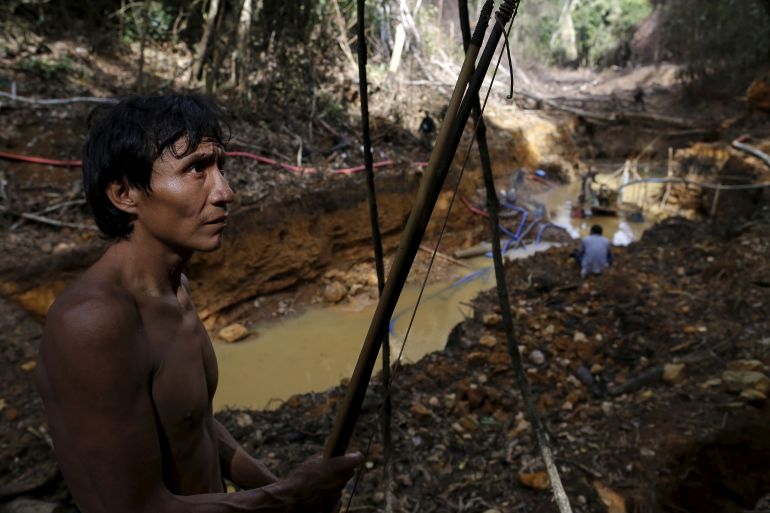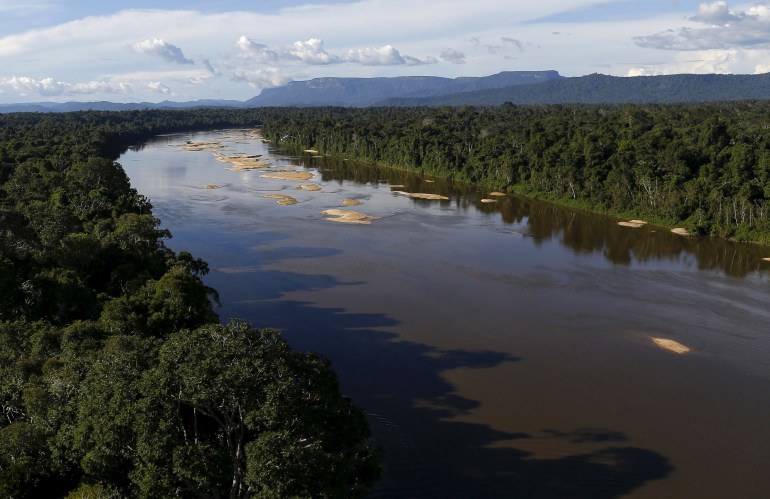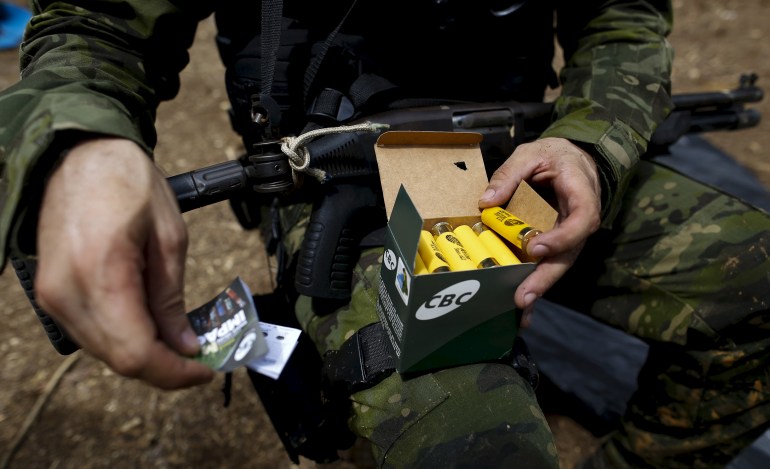Brazil: Indigenous communities reel from illegal gold mining
Spike in violence linked to illegal mining activities prompts Indigenous communities to demand protection.

Sao Paulo, Brazil – The armed attackers came in boats during the night.
Local leaders told authorities that four boatloads of men arrived last week and threw tear gas canisters at the Maikohipi village, nestled in the Palimiu region in Brazil’s largest and best-known Indigenous reserve, Yanomami.
Keep reading
list of 4 itemsBrazil judge provides a lifeline for threatened Indigenous tribe
Deforestation in Brazil Amazon rainforest soars 67 percent
Brazil: Battling Bolsonaro’s COVID misinformation
The area is home to seven tribal communities flanked by illegal gold mining operations – and the attack on June 5 was just one episode in a recent uptick of violence.
“We don’t have peace,” Junior Hekurari, head of Condisi-YY, a Yanomami health council, told Al Jazeera, explaining that the wave of attacks began after a group of tribesmen created a barrier to stop travel up the river and confiscated one illegal mining group’s diesel and other equipment.
In this remote region of the Amazon on the banks of the Uraricoera River, gangs of illegal miners, armed with rifles and other high-calibre firearms, have shot at tribesmen and even federal agents during the past month, terrorising communities and spurring calls for action from leaders, residents and advocacy groups.
In early June, United Nations human rights experts deplored the violence against the Yanomami and another Brazil Indigenous group, the Munduruku, also reeling from an uptick in violence linked to illegal mining.
“The violence means we can’t hunt or tend to our crops,” Hekurari said. “All we can think about is protecting the community, the children.”

Mineral-rich region
Bordering Venezuela and home to some 27,000 tribespeople, including groups that live in voluntary isolation, the 96,650sq-km (37,317sq-mile) Yanomami reserve is larger than Portugal and straddles two Brazilian states, Roraima and Amazonas.
The mineral-rich region has long been targeted by gold miners. During the 1980s, an estimated 40,000 miners (garimpeiros in Portuguese) invaded the reserve, bringing with them violence and diseases that killed some 15 percent of the tribe, anthropologists said.
In 1992, the Brazilian government gave the Yanomami land protected status and many of the garimpeiros left. But just one year later, 16 tribespeople were murdered by miners, who also burned down a village, in an event known as the Haximu massacre.
One of the main perpetrators, Pedro Emiliano Garcia, the only living Brazilian convicted of genocide in relation to the massacre, was rearrested last year in Roraima state capital Boa Vista with two kilogrammes of gold and accused of operating an aeroplane logistics network to ferry illegal miners and supplies to and from the Yanomami land.
Brazil’s Socioenvironmental Institute (ISA) estimated that some 20,000 illegal miners currently are hunting for gold on the reserve. Brazil’s Vice President Hamilton Mourão contests this number, saying last year that it was 3,500.
Nevertheless, experts have said the most recent uptick in illegal mining and subsequent violence is due to falling state inspections and proposed legislation that would legalise mining across Brazil’s Indigenous reserves – both campaign promises by far-right populist President Jair Bolsonaro – as well as record-high gold prices, currently at more than $60,000 per kilogramme.
“The region is totally saturated with garimpeiros … There is a conflict for territory,” said Alisson Marugal, a federal prosecutor in Roraima, who also said the infiltration of organised crime groups and increase in drug trafficking has contributed to the violence.
“The illegal mining got more violent and the relationship with the Indigenous communities got even more violent,” Marugal told Al Jazeera.
Attacks rise
About 2,000km (1,242 miles) south of the Yanomami territory, in the Amazon state of Pará, the Munduruku Indigenous tribe’s reserve in the Tapajós River region, one of the most gold-rich areas of Brazil, has also faced an uptick in violent attacks during the last month.
In mid-May, a federal court accepted charges by prosecutors against seven members of family group known as “Cow on the Grill” that controlled much of the illegal mining on the territory.
According to court documents, the group had access to vast quantities of cash, buying dozens of powerful excavators for digging up earth, as well as aircraft, and moved large amounts of gold through shell companies. The group will be tried for environmental crimes, racketeering and illegal gold extraction.
Five Indigenous men who, according to the court documents, received payments from the group and terrorised community members opposed to the illegal mining, will also stand trial for the same crimes.
Last year, two of the Indigenous men were flown in Brazilian air force planes to the capital Brasilia, where they had a closed-door meeting with Environment Minister Ricardo Salles, prompting accusations from prosecutors that state services were used to “transport criminals”.

More recently, during a federal police operation that destroyed several expensive excavators on the Munduruku reserve, the home of community leader Maria Leusa Kaba was burned down. Another Indigenous man connected to the illegal mining group has been accused of being responsible, according to local site Amazônia Real.
“They arrived with petrol in soft drink bottles, armed and shooting,” Leusa said in a video released last week through the Munduruku Ipereg Ayu association, speaking for the first time since the attack. “We received audios saying we had to be killed because we were getting in the way, that we were denouncing [the crimes to the authorities].”
Meanwhile, last week, a bus that was to be used to take Mundurku leaders opposed to illegal mining to Brasilia was attacked and the driver threatened in the municipality of Jacareacanga, where the reserve is located. Prosecutors are trying to negotiate safe escort for the leaders.
“It’s a very hostile environment with a certainty of impunity,” said Luisa Molina, an anthropologist at the University of Brasilia, who studies the Munduruku. “The Indigenous need protection.”
Illegal networks
For years now, much of the illegal mining in Brazil’s Amazon, especially on far-flung Indigenous reserves like the Yanomami or Munduruku, has been dominated by multi-layered criminal groups operating complex, moneyed and highly profitable logistics networks.
Aeroplanes, helicopters and powerful imported excavators for digging up earth as well as shell companies for money laundering, including across borders, are commonplace in Brazil’s 21st-century Amazon gold rush, which is increasingly high-tech and digital, a report by the Igarapé Institute found.
Now, authorities in Roraima are investigating reports that individuals connected to Brazil’s most powerful drug cartel, the PCC, have infiltrated illegal mining operations in Yanomami territory.
The PCC – the Portuguese acronym for “First Capital Command” – was formed in Sao Paulo’s prisons in the 1990s and has since gone on to dominate Brazil’s drug trade, sending tonnes of cocaine to Europe each year. But exact details of the group’s alleged involvement in illegal mining on the Yanomami territory are unknown.
“It’s not confirmed whether they are offering protection, charging percentages on gold extracted or controlling mining pits or dredging platforms … This is to be investigated,” said Marugal, the prosecutor.
Environmental impact
In addition to the violence, illegal gold mining is connected to grave environmental impacts such as deforestation, which has skyrocketed on both the Yanomami and Munduruku reserves in recent years.
Mercury, a highly toxic substance linked to birth defects and neurological disorders, is used in the gold amalgamation process and pollutes rivers and local food chains that Indigenous communities depend on.
Last year, a study published by Brazil’s Fiocruz health institute in partnership with the World Wildlife Fund (WWF) found that 58 percent of Munduruku Indigenous tribespeople tested in the Tapajós River region had levels of mercury higher than what is considered safe.
Meanwhile, legislation to legalise mining on Indigenous lands – touted by Bolsonaro and pro-mining politicians but blasted as unconstitutional by environmentalists – appears to have stalled in Congress.
During last month’s violence on the Munduruku reserve, Wescley Tomaz, a vocal pro-mining city councilman for Itaituba, an epicentre of Brazil’s Amazon gold trade, told local media that “the gold miner is marginalised”.
“People confuse illegal gold mining and irregular gold mining … Gold is our economy,” Tomaz said, referring to Itaituba. “Regarding mining on Indigenous lands, that’s for them to decide.”

‘We’re hostages’
While Brazil’s illegal mining networks have access to high-tech equipment, the vast majority of gold sales in the country’s mining pits are still registered using pen and paper, which experts said enables fraud.
“With beef, timber, soy … they are flawed systems, but there is the minimum of control, unlike gold,” said Larissa Rodrigues of the Choices Institute, a Brazilian social-environmental NGO. While no official statistics exist on how much of Brazil’s gold exports are believed to be linked to illegal activity, Rodrigues estimated that the figure could sit at approximately 16 percent.
Fabiano Contarato, a senator with Brazil’s Sustainability Network party, is the author of a bill that aims to create greater transparency in Brazilian gold’s supply. He said that will prevent money laundering through illegal gold mining and help reduce violence against Indigenous people.
Amid the mounting pressure, Brazil’s Supreme Court has begun a process that would force the government to remove illegal miners and loggers from the two reserves, as well as from five other Indigenous territories.
But in the meantime, attacks continue. “We’re hostages,” said Hekurari at Condisi-YY, the Yanomami health council. “The whole time we’re being intimidated.”